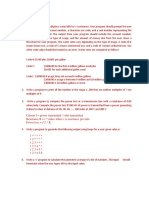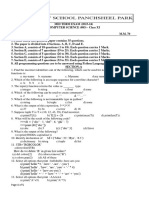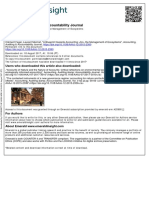Programming pt1
Uploaded by
Angi SProgramming pt1
Uploaded by
Angi SName: ________________________
Programming pt1 Class: ________________________
Date: ________________________
Time: 42 minutes
Marks: 31 marks
Comments:
Wallington High School for Girls Page 1 of 11
An algorithm, that uses the modulus operator, has been represented using pseudo-code in
1. Figure 1.
• Line numbers are included but are not part of the algorithm.
Figure 1
1 i ← USERINPUT
2 IF i MOD 2 = 0 THEN
3 OUTPUT i * i
4 ELSE
5 OUTPUT i
6 ENDIF
The modulus operator is used to calculate the remainder after dividing one integer by another.
For example:
• 14 MOD 3 evaluates to 2
• 24 MOD 5 evaluates to 4
(a) Shade one lozenge that shows the line number where selection is first used in the
algorithm in Figure 1.
A Line number 1
B Line number 2
C Line number 3
D Line number 4
(1)
(b) Shade one lozenge that shows the output from the algorithm in Figure 1 when the user
input is 4
A 0
B 2
C 4
D 8
E 16
(1)
Wallington High School for Girls Page 2 of 11
(c) Shade one lozenge that shows the line number where assignment is first used in the
algorithm in Figure 1.
A Line number 1
B Line number 2
C Line number 3
D Line number 4
(1)
(d) Shade one lozenge that shows the line number that contains a relational operator in the
algorithm in Figure 1.
A Line number 1
B Line number 2
C Line number 3
D Line number 4
(1)
Figure 1 has been included again below.
Figure 1
1 i ← USERINPUT
2 IF i MOD 2 = 0 THEN
3 OUTPUT i * i
4 ELSE
5 OUTPUT i
6 ENDIF
(e) Shade one lozenge to show which of the following is a true statement about the algorithm
in Figure 1.
A This algorithm uses a Boolean operator.
B This algorithm uses a named constant.
C This algorithm uses iteration.
D This algorithm uses the multiplication operator.
(1)
Wallington High School for Girls Page 3 of 11
(f) Figure 2 shows an implementation of the algorithm in Figure 1 using the Python
programming language.
• Line numbers are included but are not part of the program.
Figure 2
1 i = int(input("Enter a number: "))
2 if i % 2 == 0:
3 print(i * i)
4 else:
5 print(i)
The program in Figure 2 needs to be changed so that it repeats five times using definite
(count controlled) iteration.
Shade one lozenge next to the program that does this correctly.
A for x in range(0, 5):
i = int(input("Enter a number: "))
if i % 2 == 0:
print(i * i)
else:
print(i)
B for x in range(0, 6):
i = int(input("Enter a number: "))
if i % 2 == 0:
print(i * i)
else:
print(i)
C x = 1
while x != 6:
i = int(input("Enter a number: "))
if i % 2 == 0:
print(i * i)
else:
print(i)
x = x + 1
D x = 6
while x != 0:
i = int(input("Enter a number: "))
if i % 2 == 0:
print(i * i)
else:
print(i)
x = x – 1
(1)
(Total 6 marks)
Wallington High School for Girls Page 4 of 11
A theme park charges £15 per person for a daily ticket. If there are six or more people in a group,
2. the group is given a £5 discount.
Write a Python program to calculate the total charge for a group of people visiting the theme
park.
The program must:
• get the user to enter the number of people in a group
• calculate the total charge by:
○ charging £15 per person
○ reducing the total charge by £5 if there are six or more people
• output the total charge.
You should use indentation as appropriate, meaningful variable name(s) and Python syntax in
your answer.
The answer grid below contains vertical lines to help you indent your code.
(Total 6 marks)
Wallington High School for Girls Page 5 of 11
Wallington High School for Girls Page 6 of 11
(a) The figure below shows a line of Python code that creates a list of fruit names.
3.
fruits = ["banana", "apple", "orange", "pear",
"grape", "pineapple"]
Extend the program in the figure above. Your answer must be written in Python.
The program should get the user to enter a word and perform a linear search on the list
fruits to find if the word is in the list or not.
The program should:
• ask the user what word they would like to find
• output the message True if the word is found
• output the message False if the word is not found.
You must write your own linear search routine and not use any built-in search function
available in Python.
You should use indentation as appropriate, meaningful variable name(s) and Python
syntax in your answer.
The answer grid below contains vertical lines to help you indent your code.
(7)
Wallington High School for Girls Page 7 of 11
fruits = ["banana", "apple", "orange", "pear",
"grape", "pineapple"]
Wallington High School for Girls Page 8 of 11
(b) State why a binary search cannot be used on the list fruits
___________________________________________________________________
___________________________________________________________________
(1)
(Total 8 marks)
This question is about a dice game played against a computer.
4.
The aim of the game is to get as close to a score of 21 as you can, without going over 21. If your
score goes over 21 then you lose.
The player’s score starts at 0.
For each turn:
• two dice (each numbered from 1 to 6) are rolled
• the total of the two dice rolls is added to the player’s score
• the value of each dice and the player’s new total is output
• if the current score is less than 21, the player is asked if they would like to roll the dice
again: if the player says yes, they get another turn; otherwise, the game ends.
At the end of the game, the program should work as follows:
• if the final score is 21, output a message to say the player has won
• if the final score is greater than 21, output a message to say the player has lost
• if the final score is less than 21, the program generates a random number between 15 and
21 inclusive:
○ if this random number is greater than the player’s final score, output a message to
say the player has lost
○ otherwise, output a message to say the player has won.
The figure below shows the output of a program that plays this dice game.
Roll 1: 1
Roll 2: 4
Current score: 5
Would you like to roll again? yes
Roll 1: 1
Roll 2: 6
Current score: 12
Would you like to roll again? yes
Roll 1: 1
Roll 2: 2
Current score: 15
Would you like to roll again? yes
Roll 1: 6
Roll 2: 1
Current score: 22
You lost!
Wallington High School for Girls Page 9 of 11
Write a Python program to simulate this game.
The first line has been written for you in the answer grid.
The dice rolls are carried out by the program generating random numbers between 1 and 6. You
will need to use the Python function random.randrange(a, b) which generates a random
integer in the range a to b starting at a but finishing one before b.
You should use indentation as appropriate, meaningful variable name(s) and Python syntax in
your answer.
The answer grid below contains vertical lines to help you indent your code.
(Total 11 marks)
Wallington High School for Girls Page 10 of 11
import random
Wallington High School for Girls Page 11 of 11
You might also like
- Biology Investigatory Project On Mendelian Disorders86% (14)Biology Investigatory Project On Mendelian Disorders42 pages
- 8525 1B QP ComputerScience G 16may22 PMNo ratings yet8525 1B QP ComputerScience G 16may22 PM40 pages
- Delhi Public School, Gandhinagar Half Yearly Examination (2023-24) Computer Science (Set-1)No ratings yetDelhi Public School, Gandhinagar Half Yearly Examination (2023-24) Computer Science (Set-1)8 pages
- Practical 1: AIM: Installation of Configuration of Python. Along With Its All Major Editors100% (1)Practical 1: AIM: Installation of Configuration of Python. Along With Its All Major Editors54 pages
- 2023-T1-SDD-Y11-Assessment-Task-1 Marking CriteriaNo ratings yet2023-T1-SDD-Y11-Assessment-Task-1 Marking Criteria5 pages
- Marking Scheme Cs GR 10 11 Mockexam Paper2No ratings yetMarking Scheme Cs GR 10 11 Mockexam Paper221 pages
- Data Science & Data Analyst_22_2_2024_1708610009147_Tuples (2)No ratings yetData Science & Data Analyst_22_2_2024_1708610009147_Tuples (2)4 pages
- XI - TERM1 - Computer Science - QP - 240308 - 214033No ratings yetXI - TERM1 - Computer Science - QP - 240308 - 2140336 pages
- Programming Essentials in Python Introduction To Python: What You Will LearnNo ratings yetProgramming Essentials in Python Introduction To Python: What You Will Learn23 pages
- Department of Computer Science Iqra University, Karachi: 1 Is Pseudocode 2 Is AwesomenessNo ratings yetDepartment of Computer Science Iqra University, Karachi: 1 Is Pseudocode 2 Is Awesomeness5 pages
- GCSE L1 L2 Computer Science 2020 Sample Assessment Materials For Paper 2No ratings yetGCSE L1 L2 Computer Science 2020 Sample Assessment Materials For Paper 229 pages
- C2 Student Checklist: The Periodic TableNo ratings yetC2 Student Checklist: The Periodic Table2 pages
- Glossary - People and The Biosphere - Edexcel Geography GCSENo ratings yetGlossary - People and The Biosphere - Edexcel Geography GCSE3 pages
- N 407-Compass Work For Basic Studies s4 Ready100% (1)N 407-Compass Work For Basic Studies s4 Ready20 pages
- Chapter 10_ Prosocial Behaviour - Why Do People HelpNo ratings yetChapter 10_ Prosocial Behaviour - Why Do People Help27 pages
- Cambridge Lower Secondary Checkpoint: Anisah AbdulssalamNo ratings yetCambridge Lower Secondary Checkpoint: Anisah Abdulssalam20 pages
- Allama Iqbal Open University Islamabad Assignment No: 01No ratings yetAllama Iqbal Open University Islamabad Assignment No: 0122 pages
- Visvesvaraya Technological University: (Your Internship Title)No ratings yetVisvesvaraya Technological University: (Your Internship Title)4 pages
- Ch 5 Imp questions_50682bf4-83ae-4ae8-976b-87e8b527d45eNo ratings yetCh 5 Imp questions_50682bf4-83ae-4ae8-976b-87e8b527d45e21 pages
- ARI 126 (2017) 256-262 Practical Implementation of ISO 11929 2010 - de Felice, P., Jerome, S., & Petrucci, A.No ratings yetARI 126 (2017) 256-262 Practical Implementation of ISO 11929 2010 - de Felice, P., Jerome, S., & Petrucci, A.21 pages
- Full download Science in Nursing and Health Care 2nd Edition Mark A. Foss ebook PDF & DOCX all chapters100% (1)Full download Science in Nursing and Health Care 2nd Edition Mark A. Foss ebook PDF & DOCX all chapters78 pages
- Actividades 1° de Secundaria: 1st English BasicsNo ratings yetActividades 1° de Secundaria: 1st English Basics7 pages
- Accounting, Auditing & Accountability Journal: Article InformationNo ratings yetAccounting, Auditing & Accountability Journal: Article Information33 pages
- (Ebooks PDF) Download Chemical Physics of Molecular Condensed Matter Kazuya Saito Full Chapters100% (4)(Ebooks PDF) Download Chemical Physics of Molecular Condensed Matter Kazuya Saito Full Chapters52 pages
- HLST320 Assignment1Rubric OkpomorVeronica 2966800No ratings yetHLST320 Assignment1Rubric OkpomorVeronica 29668004 pages





























































































